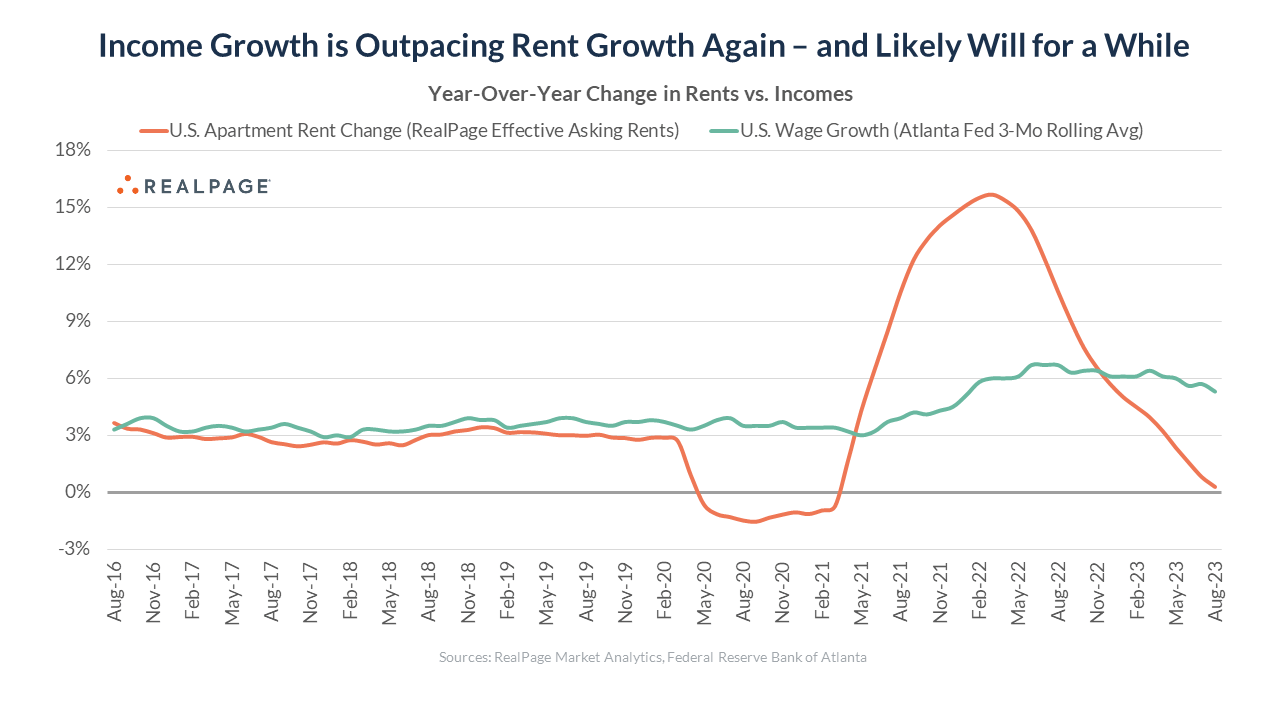Flip the Script: Wage Growth Is Outpacing Rent Growth Again

There’s a significant plot shift occurring in the U.S. rental housing market: Wages are outpacing rents again, and by a widening margin. And all signs suggest more of the same for the near future.
Year-over-year U.S. wage growth has topped effective apartment rent growth for nine consecutive months. Through August 2023, wages topped rents 5.3% to 0.3%. The income data comes from the Federal Reserve Bank of Atlanta’s Wage Growth Tracker, while the rent data reflects effective asking rents for market-rate apartments tracked by RealPage.
Rent growth is rapidly decelerating due to an historic surge in new apartment construction. That wave came about, in part, due to 2021’s perfect storm of ultra-low occupancy, high rent growth plus low interest rates creating a fertile landscape for apartment construction to surpass 50-year highs. During a 19-month stretch in 2021-22, rents cumulatively grew almost twice as fast as wages.
But that gap is quickly shrinking, and it wouldn’t be shocking if it’s entirely erased by the end of 2024. Rent growth is expected to remain muted (and even remain negative in some markets). Even a moderating pace of wage growth would likely be enough to close the gap created in 2021-22.
This is a very positive shift for affordability ... and by extension, for rental housing demand. Improved affordability should widen the demand pool to some degree. Rent-to-income ratios hit a decade high earlier this year at 23.1% (among actual lease signers in the RealPage dataset), but that number will likely tick back below 23% before year end.
Furthermore, IF rents continue to flatten/fall (near certainty), inflation continues to cool (probably?) and employment remains healthy (less certainty), that would suggest we’re entering a stretch where renters have increased spending power. Upper-income renters, in particular, have more options than in many years thanks to a large number of newly built apartments plus growing rent concessions.
To be fair: This doesn't solve America’s affordability challenges. We’re still short millions of low-income affordable housing units. But it’s still a significant plot shift that benefits renters – and likely rental housing operators, too, via strengthening demand at a time when supply is outpacing demand.
A Note on Methodology
It’s important to note that this analysis focuses on renters signing new leases. Renewal rents generally did not rise as fast as new lease rents during the run-up, and therefore renters may see renewals growing somewhat more than asking rents – although the nominal renewal rent will likely still be cheaper than the asking rent.
Also, there are many ways to measure rents versus incomes. The Atlanta Fed’s wage tracker used here is the most real-time national measure for the broader population. You could argue household income is a better measure, but that data is only updated through 2022. (And even by that measure, incomes came within 32 bps of rents, and 2023 will almost certainly show incomes outpacing rents once that data is released.)
Additionally, we usually prefer to share renter household incomes among those actually signing leases for a more apples-to-apples comparison. By that measure, incomes grew much faster than what government data showed in 2021-22, which could reflect that market-rate renters fared better than the overall population. Still, even by that measure, the trend is the same – with rents outpacing wages until more recently.
We used the Atlanta Fed here because it gives a broader perspective than looking more narrowly at renters signing leases, even if it’s not apples to apples.
But no matter your preferred methodology, the narrative shift is undeniable: Incomes are outpacing rents again, and likely will through at least 2024.







